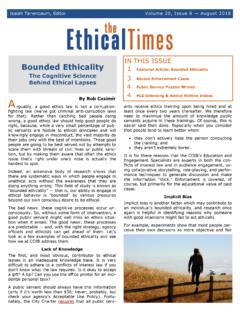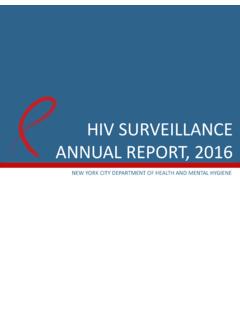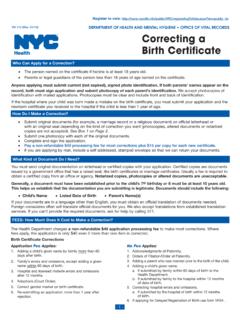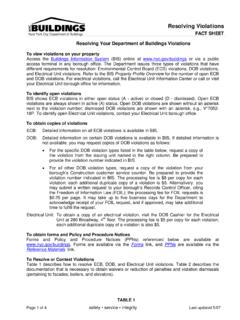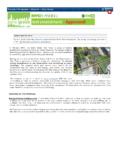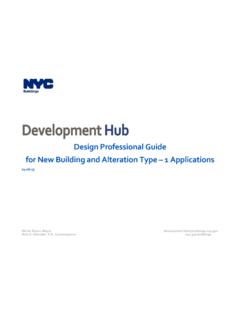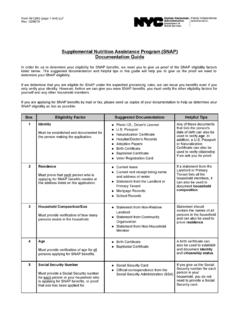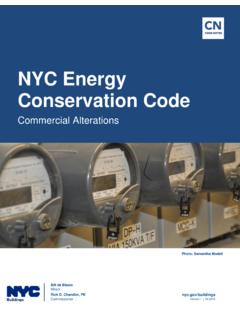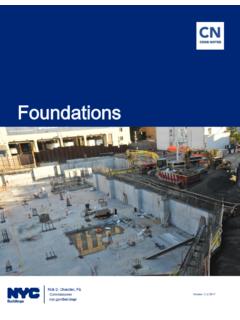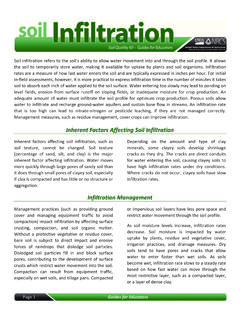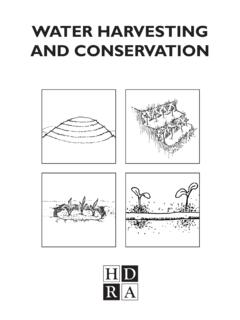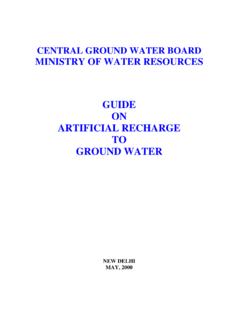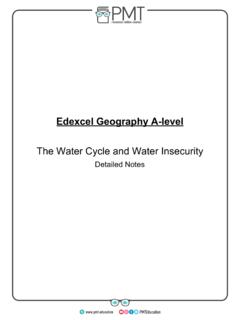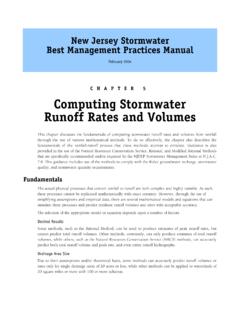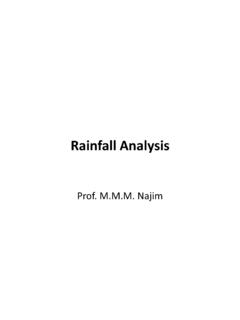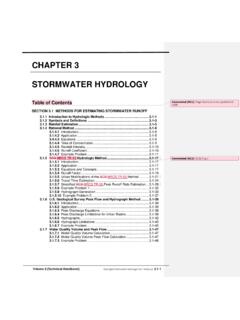Transcription of NEW YORK CITY STORMWATER RESILIENCY PLAN
1 | NYC STORMWATER RESILIENCY PLANNEW york city S TORM WAT ER RESILIENCY PLANH elping New Yorkers understand and manage vulnerabilities from extreme rainMAY 2021 Cover photo by Jean Schwarzwalder, New york city Department of Environmental | NYC STORMWATER RESILIENCY PLANTABLE OF FLASH OF RESEARCH EFFORT AND MODELING york city STORMWATER FLOOD york city STORMWATER RESILIENCY A: ONGOING STORMWATER B: MODELING TERMS AND ACRONYMSAgeNCIes AND OffIC esBWSO: NYC Department of Environmental Protection Bureau of Water & Sewer OperationsCAU: NYC Mayor s Community Affairs UnitEM: NYC Emergency ManagementDEP: NYC Department of Environmental ProtectionDCP: NYC Department of city PlanningDOE: NYC Department of Education DOT: NYC Department of TransportationDSNY: NYC Department of SanitationFDNY: NYC Fire DepartmentMOR: NYC Mayor s Office of ResiliencyMOS: NYC Mayor s Office of SustainabilityMTA: Metropolitan Transportation AuthorityNPCC: New york city Panel on Climate ChangeNYCHA: New york city Housing AuthorityNYPD: NYC Police DepartmentNYSDEC: New york State Department of Environmental ConservationParks: NYC Department of Parks & RecreationSCA.
2 NYC School Construction AuthorityOTheR ACRONyms AND TeRms:CSO: Combined Sewer OverflowDEM: Digital Elevation ModelFY: Fiscal YearGIS: Geographic Information SystemsH&H: Hydrologic & Hydraulic (used to describe STORMWATER models)IDF: Intensity-Duration-Frequency Curve (used to describe rainfall in STORMWATER models)LiDar: Light Detection and Ranging (used to describe digital elevation models)LTCP: Long Term Control PlanMS4: Municipal Separate Storm Sewer SystemNPCC: New york city Panel on Climate ChangePLUTO: Property Land Use Tax Lot Output mapROW: Right of WaySewershed: an area of land where all sewers flow to a single : Standard Operating ProcedureSLR: Sea Level RiseSWMP: STORMWATER Management Program WRRF: Wastewater Resource Recovery | NYC STORMWATER RESILIENCY PLANCLIMATE CHANGE CONTEXTNew york city is facing a wide variety of climate hazards that are not only felt today but will impact every aspect of life in the city over the coming decades.
3 New Yorkers are well aware of the hazards associated with stronger coastal storms after Superstorm Sandy claimed 44 lives and caused over $60 billion in regional damage in October 2012. Heat waves cause over 450 emergency department visits, 150 hospital admissions, and 13 heat stroke deaths a n nu a l As a result of these hazards, New york city has initiated ambitious coastal protection projects as well as a comprehensive Cool Neighborhoods strategy. This plan initiates New york city s planning process for another climate risk, extreme rainfall events, which combined with sea level rise and other climate hazards will contribute to the city s overall climate risk going forward.
4 Extreme rainfall events are becoming more frequent and disruptive in New york city and beyond. According to The National Climate Assessment, which summarizes current and future impacts of climate change on the United States, the heaviest 1 percent of daily rainfalls increased by 70 percent in the Northeast United States between 1958 and Climate projections suggest that this trend will continue and that New york city will likely experience increased precipitation in the future. The New york city Panel on Climate Change (NPCC) anticipates that by the end of the century, the city could experience as much as 25 percent more annual rainfall than today, and times as many days with more than one inch of Without continued investment in strategies to prepare for the impacts of extreme rain events, NYC residents will experience increasing damage to private property, disruptions of surface and below ground transportation, and impacts to waterbodies.
5 Building on the NPCC climate projections, the city has undertaken detailed research to better quantify how extreme precipitation will impact neighborhoods citywide. This analysis focuses specifically on rainfall (rather than other forms of precipitation such as snow or sleet) because it is overwhelmingly the driver of precipitation-based flooding in NYC. The research will enable new, tailored solutions to manage this climate AND MAPPINGV ulnerability to extreme rainfall is an emerging area of study for municipalities in the United States. In 2017, New york city embarked on the STORMWATER RESILIENCY Study to gain a fuller understanding of how more frequent and extreme rain events will affect the city .
6 The Study was spearheaded by a multifaceted team of New york city agency staff, consulting teams, and academic partners. Led by NYC Mayor s Office of RESILIENCY (MOR), NYC Department of Environmental Protection (DEP), and NYC Emergency Management (EM), the team was supported by staff from over 20 city agencies, external consultants, as well as an academic team from Brooklyn College, the Stevens Institute of Technology, the New School and Colorado State Study included a novel modeling effort that produced, for the first time, public maps depicting vulnerability to rainfall -driven flooding.
7 Prior to this effort, there had been no citywide analysis performed focusing on rainfall -induced inland flooding that utilized the city s drainage models. The city has published maps of two storm scenarios, both of which incorporate future sea level rise projections. Maps can be found at subsequent pages describe the research and mapping effort performed during the Study that resulted in NYC s first STORMWATER RESILIENCY Plan. STORMWATER RESILIENCY PLANIn 2018, New york city Council passed Local Law 172,4 which required the city to produce maps showing areas of the city most vulnerable to increased flooding due to the anticipated effects of climate change and publish a long-term plan to prevent or mitigate such increased flooding.
8 Consistent with the Local Law, the plan and maps will be updated at least every four years, and periodically as new modeling is available and as climate change projections are updated. The STORMWATER RESILIENCY Plan (the Plan ) outlines the city s approach to managing the risk of extreme rain events. Truly holistic planning for rain-driven flooding involves consideration of both large storm events and the chronic worsening of average conditions. For this reason, the Plan addresses emergency response procedures as well as accounting for increasing rainfall in standard design and long term planning of STORMWATER infrastructure.
9 The Plan commits to four goals that optimize emergency response to extreme rainfall events and ensure that future city investments manage this climate risk. Each goal includes supporting sub-initiatives. 1. Inform the public about flood vulnerability from extreme rain;2. Update NYC s flash flood response procedures to prioritize response in vulnerable areas;3. Advance policies that reduce urban flooding and research that informs future risk; 4. Leverage STORMWATER investments to help manage future flood risk from extreme rain and sea level rise. Future investments can alleviate flooding throughout the city .
10 This document provides an overview of NYC s existing drainage network, which is critical to understanding the base capacity to manage rain-driven flooding in the future. Flash flood emergency procedures are also examined for optimization under increasingly extreme conditions. The document interprets findings from the modeling effort, presents the public STORMWATER maps, and finally outlines the actions the city is taking to manage this climate risk. | NYC STORMWATER RESILIENCY PLANSTORMWATER INVESTMENTSU nderstanding NYC s drainage network is essential to STORMWATER RESILIENCY planning. DEP manages the city s water and wastewater services and has been committed to investments in, and policy changes around, drainage improvement, green infrastructure and on-site STORMWATER management.
